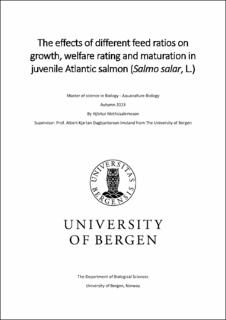| dc.description.abstract | The world population is increasing day by day and has surpassed 8 billion, and there will continue to be high demands of more protein to feed the world. Salmon farming is a rapidly growing industry and has been for the past decades. The pressure for more protein and better operational results for the salmon producers, requires the salmon farmers to adapt their production method by increasing intensiveness in their rearing of the fish, which has resulted in more maturation of the salmon. The objectives of this study were to assess if there were a connection between different feed ratios and growth, welfare rating and early maturation of juvenile Atlantic salmon. Juvenile salmon (n = 450) were reared under 3 different feed rations (100%, 50% and 33%), producing nine experimental groups (3 tanks for each feed ratio) where 50% of fish was PIT-tagged individually in each tank. The criterions used to follow the development of growth were the weight, length, condition factor (K-factor) and specific growth rate (SGR). Number of fin wounds were used as the welfare indicator, and to inspect the development of maturation, the fish was euthanized, killed, and development of the gonads monitored by visual inspection. The fully fed group (100r) showed better growth and welfare rating compared to the lower fed groups (50r and 33r), however the growth of the lower fed groups was closer to the full fed groups, than expected. There was a significant difference found between the welfare rating of all the feed groups during the last sample, where the 100r showed the best rating and the 33r group the worst. Barely any difference was found in the maturation of the smolts, non at the female salmon and only in two different maturation stages for the males. Present findings indicate possible research avenues to help the salmon producers with their smolt strategies that can result in higher welfare rating and in lower maturation later in the production cycle. However, future research looking at other factors could make that clearer like temperature, light regimes, and utilization of the feed which could affect the producers feed strategies. | |
